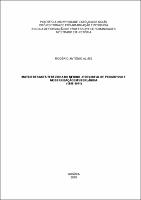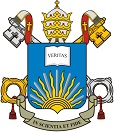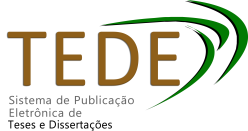| Compartilhamento |


|
Use este identificador para citar ou linkar para este item:
http://tede2.pucgoias.edu.br:8080/handle/tede/3976| Tipo do documento: | Dissertação |
| Título: | MATRIZ DE SANTA TEREZINHA DO MENINO JESUS: IDEAL DE PROGRESSO E MODERNIZAÇÃO EM UBERLÂNDIA (1888-1941) |
| Autor: | Alves, Rogério Antonio  |
| Primeiro orientador: | Sugizaki, Eduardo |
| Primeiro membro da banca: | Nascimento, Renata Cristina de Sousa |
| Segundo membro da banca: | Menezes, Marcos Antonio de |
| Resumo: | Desvendar a trama histórica tecida acerca do local e regional leva-nos ao encontro de minúcias que nos fazem compreender um leque de questões relacionadas a um campo ainda mais amplo. Ao debruçarmo-nos sobre a história da cidade de Uberlândia, no Estado de Minas Gerais, observamos uma amplitude de objetos, fatos e questões. É a partir desta realidade, que nos propusemos aqui a compreender o percurso feito pela Igreja Católica Apostólica Romana, e dentro desta, sua atuação no meio político, social e econômico sob a égide da modernização. Nessa perspectiva, objetiva-se compreender o processo de derrubada da antiga Matriz Nossa Senhora do Carmo e a construção da nova Matriz de Santa Terezinha do Menino Jesus e da Sagrada Face, que ocorre entre os anos de 1930 a 1941, sob o signo do novo (progresso). A partir da edificação Matriz de Santa Terezinha do Menino Jesus e da Sagrada Face, procura-se visualizar o contexto maior da história nos entremeios entre o macro e o micro, que impõe à instituição Igreja Católica nova postura no meio social. A conjuntura da modernidade (rolo compressor), no inicio do século XX, traz para sociedade novas vivências que irão fazer com que a Igreja, em um primeiro momento, as veja como estranhas, mas que com tempo assetam-se com nova visão nas práticas de fé desta Instituição. Nossas discussões perpassam pela perspectiva teórica-metodológica situada no campo da história cultural, nas discussões acerca da história e cidade propostas por Leonardo Benevolo e José Evaldo de Mello Doin. A documentação utilizada no presente trabalho, jornais, atas e livros de tombo foi encontrada em sua maioria no arquivo público municipal de Uberlândia e nos acervos da Diocese de Uberlândia. A partir das discussões feitas, percebe-se que o ideal de progresso que permeia a sociedade Uberlandense no período proposto, faz com que a Igreja Católica acompanhe o mesmo, ao colaborar com o apagamento e esquecimento de sua própria história a fim de modernizar-se. Constata-se, ainda, que a Igreja Católica estabeleceu uma relação dialógica com a instância política no intuito de demarcar seu espaço no centro da cidade de Uberlândia. |
| Abstract: | Unveiling the historical plot woven about the local and regional leads us to find of the minutiae that makes us understand a range of issues related to an even broader field. When we look at the history of the city of Uberlândia, in the state of Minas Gerais, we observe a range of objects, facts and issues. It’s from this reality that we proposed here to understand the course taken by the Roman Catholic Church, and within it, its action in the political, social and economic environment under the aegis of modernization. From this perspective, the purpose is to understand the process of overthrowing the old main church of Our Lady of Mount Carmel and the construction of the new main church of Saint Thérèse of Child Jesus and the Holy Face, that happens between the years of 1930 and 1941 under the sign of the new (progress). From the building of the Saint Thérèse of the Child Jesus and the Holy Face, the point is to visualize the greater context of history between the macro and the micro, which imposes on the Catholic Church institution a new posture in the social environment. At the beginning of the twentieth century, the conjuncture of modernity (steamroller) brings to society new experiences that will make the Church, at first sight, to see them as strange, but with the passage of time they settle themselves like a new vision in the practice of this Institution. Our discussions go through the theoretical-methodological perspective in the field of cultural history, in the discussions about the history and city proposed by Leonardo Benevolo and José Evaldo de Mello Doin. The documentation used in this work, newspapers, minutes and books of tombo was found mostly in the public archive of Uberlândia and in the collections of the Diocese of Uberlândia.From the discussions made, it’s perceived that the ideal of progress that permeates the Uberlandian society in the proposed period, makes the Catholic Church to follow the same, collaborating with the erasure and forgetting of its own history, intending to modernize itself. It’s also verified that the Catholic Church established a dialogical relation with the political instance in order to demarcate its space in the center of the city of Uberlândia. |
| Palavras-chave: | Igreja católica – Matriz de Santa Terezinha – Uberlândia Catholical Church, main church of Saint Thérèse, Uberlândia |
| Área(s) do CNPq: | CIENCIAS HUMANAS::HISTORIA |
| Idioma: | por |
| País: | Brasil |
| Instituição: | Pontifícia Universidade Católica de Goiás |
| Sigla da instituição: | PUC Goiás |
| Departamento: | Escola de Formação de Professores e Humanidade::Curso de História |
| Programa: | Programa de Pós-Graduação STRICTO SENSU em História |
| Citação: | Alves, Rogério Antonio. MATRIZ DE SANTA TEREZINHA DO MENINO JESUS: IDEAL DE PROGRESSO E MODERNIZAÇÃO EM UBERLÂNDIA (1888-1941). 2018. 147 f. Dissertação (Programa de Pós-Graduação STRICTO SENSU em História) - Pontifícia Universidade Católica de Goiás, Goiânia-GO. |
| Tipo de acesso: | Acesso Aberto |
| URI: | http://tede2.pucgoias.edu.br:8080/handle/tede/3976 |
| Data de defesa: | 23-Mar-2018 |
| Aparece nas coleções: | Mestrado em História |
Arquivos associados a este item:
| Arquivo | Descrição | Tamanho | Formato | |
|---|---|---|---|---|
| ROGÉRIO ANTÔNIO ALVES.pdf | Texto Completo | 1,51 MB | Adobe PDF |  Baixar/Abrir Pré-Visualizar |
Os itens no repositório estão protegidos por copyright, com todos os direitos reservados, salvo quando é indicado o contrário.




